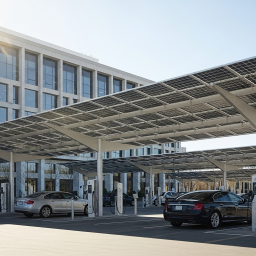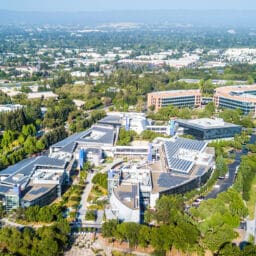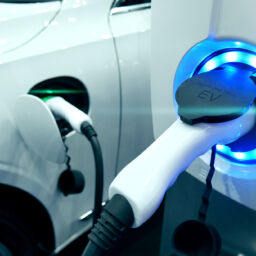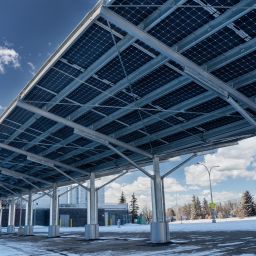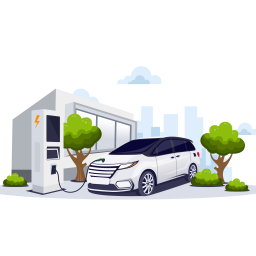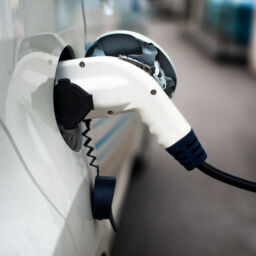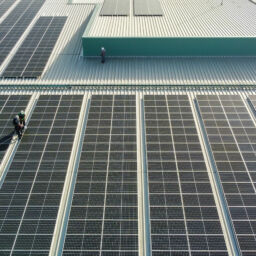
As the electric vehicle (EV) revolution accelerates and sustainability becomes a business imperative, commercial property owners and developers are increasingly looking for smart, future-proof energy solutions. One of the most compelling strategies is the integration of solar carport canopies with EV charging infrastructure – specifically DC Fast Charging. This bundled approach not only offers enhanced sustainability credentials—it delivers tangible financial, operational, and regulatory advantages.
From a financier’s standpoint, here’s why this integrated solution is a game-changer:
1. Energy Arbitrage: Turning Carports into Revenue Streams
Pairing solar generation with EV charging unlocks energy arbitrage opportunities that can significantly boost project economics.
- Peak Shaving: Solar carports can offset energy consumed by EV chargers during peak utility rate periods, reducing demand charges—a major cost component for DC Fast Chargers.
- Time-of-Use Optimization: With the right energy storage and software, solar energy can be stored or directed toward EV chargers when utility rates are highest or to optimizing savings under a traditional Power Purchase Agreement (PPA).
- Grid Services Revenue: In certain utility territories, integrated systems can participate in demand response or capacity markets, opening additional revenue streams.
For financiers, this layered revenue model strengthens the underlying cash flows, making these types of projects more attractive and bankable.
2. Shading: More Than Just Comfort
Shading provided by solar carports adds value beyond aesthetics or driver convenience—it contributes to asset longevity and cost savings.
- Vehicle Protection: Covered parking increases tenant and employee satisfaction while protecting vehicle paint, batteries, and interiors from heat damage—an important consideration for fleets.
- Enhanced Site Value: Shaded, solar-equipped parking offers a premium amenity that can improve lease rates and attract sustainability-minded tenants.
3. Combined Permitting & Construction: Streamlined Project Delivery
Permitting and interconnection can be one of the most complex, time-consuming parts of any solar or EV infrastructure project. Bundling them simplifies the process.
- Fewer Permitting Delays: Local authorities often prefer integrated plans over multiple piecemeal applications, especially when EV infrastructure is combined with clean generation.
- Reduced Soft Costs: Shared engineering, design, and construction processes mean fewer redundant site visits, less paperwork, and streamlined inspections.
- Faster Time-to-Revenue: Collapsing timelines and reducing permitting complexity leads to quicker interconnection and commissioning—critical for hitting incentive windows and maximizing tax credits.
For developers & financiers, fewer delays mean reduced overhead and quicker monetization of investment.
4. Incentive Stacking & Tax Optimization
Bundling solar carports with EV chargers can qualify a project for multiple federal, state, and local incentives—often with overlapping benefits.
- Inflation Reduction Act (IRA): Commercial solar and EV infrastructure both qualify for tax credits under the IRA, with potential bonus credits for domestic content, energy communities, and prevailing wage compliance.
- MACRS & Bonus Depreciation: Integrated systems often qualify for accelerated depreciation schedules, providing upfront tax shield benefits.
- Utility & State Rebates: Many utilities offer EV charger rebates that can be layered with solar incentives, improving IRR and payback metrics.
From a financial structuring perspective, these incentives can be stacked to maximize net present value (NPV) and attract a wider pool of tax equity investors.
5. Future-Proofing Commercial Assets
Finally, integrating DC Fast Chargers with solar carports is a forward-looking strategy that positions commercial properties for future growth.
- Fleet Electrification: As fleets transition to electric, the need for on-site charging will skyrocket. Properties with solar-integrated charging infrastructure will be in high demand.
- Resilience & ESG Metrics: Solar + EV infrastructure supports energy resilience goals and boosts ESG ratings—critical metrics for institutional investors.
- Tenant Retention: Properties offering sustainable, tech-forward amenities attract and retain premium tenants in a competitive market.
Financing Smarter, Sustainable Infrastructure
From a financier’s lens, the integration of solar carport canopies with EV charging is not just a green choice—it’s a strategic investment. It enables stronger returns through energy arbitrage, reduces project soft costs, opens doors to incentive stacking, and positions assets at the forefront of the clean transportation movement.
For commercial developers and property owners, this bundled approach isn’t just about checking the sustainability box—it’s about unlocking a smarter capital stack and future-proofing assets in a fast-evolving energy landscape.



